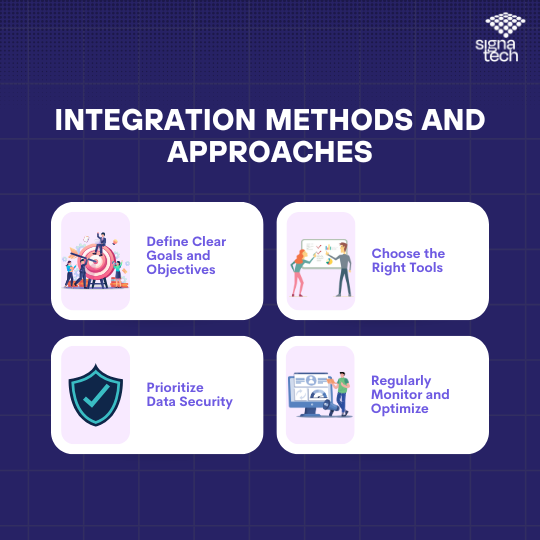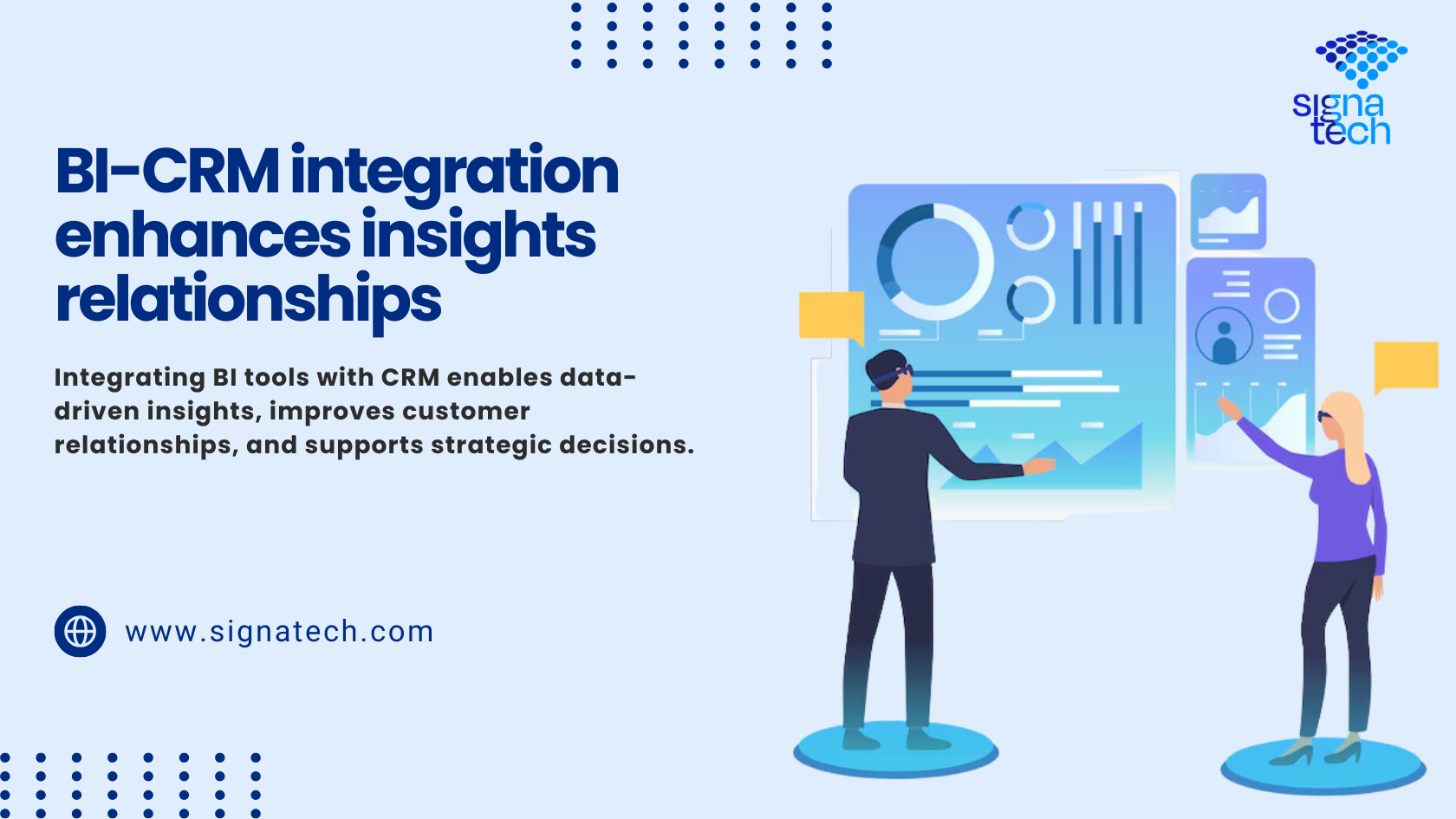Business intelligence is now an indispensable component in the business environment, where data is the key to decision-making, and BI and CRM systems are no exception. Business enterprises are aware of the importance of analyzing information that helps assess customer demands and optimize the sales process. Integrating BI Tools with CRM Systems provides a powerful approach for organizations, enabling them to convert raw data into meaningful insights and facilitate better, quicker decision-making.
Understanding BI Tools and CRM Systems
In order to understand the advantages of integration, one must first find out what is done by BI tools and CRM systems individually.
- BI Tools are defined as applications that assist organizations in processing data to make decisions. These tools provide tools such as data graphical interface, performance index, and trends analysis that is useful in evaluation of the company’s performance.
- CRM Systems are used for the purpose of interacting with customers and capturing critical information such as customers’ purchase patterns, their feedback and other related activities. It is a method of organizing the relationship between the company and the customers and assisting the sales force in handling leads and calls.
When integrated, BI tools and CRM systems support organizations in analyzing customer data more profoundly and tactically than in the case of using only one system.
Key Benefits of Integrating BI Tools with CRM Systems
- Improved Customer Insights
Integration enables the customer to be viewed holistically from the behavioral and purchase pattern perspective. BI analysis is used to determine which products are in high demand, during which period, and what drives customer loyalty. This information is particularly useful for designing promotional messages and enhancing the clients’ experience. - Enhanced Sales Strategies
When BI insights are embedded within CRM systems, they provide sales teams with real-time information that they can use when contacting their clients. This can help them understand the prospects, know who is a valuable customer and what the buyer may need before they know it, which enhances the sales strategy. - Operational Efficiency
Data integration eliminates the need to switch between different applications in order to get information. All of the information that a team requires can then be found in one location, thus increasing efficiency. It also means automation of repetitive work, which keeps the employees with more important tasks to complete. - Predictive Analysis for Future Planning
With BI tools, it is possible to do predictive analysis, which, when Integrating BI Tools with CRM Systems, can predict the next course of action of the customers and the possible changes in the market. This makes it possible for organizations to strategize and prepare for the needs of the customers, manage their stocks, and alter their sale strategies to fit the needs of the customers. - Better Decision-Making Across Departments
Integration enables one department to share consistent customer data with another department. This helps avoid situations where the marketing department comes up with a strategy that will see the company flood the market with a certain product, only for the sales team to downplay this product’s importance in customer care, or vice versa.
How BI Tool Integration with CRM Works
BI tools have to be interfaced with CRM systems; this entails Integrating BI Tools with CRM Systems by linking the CRM data feeds to BI systems so that the data can be transferred and analyzed. This can be done in several ways, for instance, through APIs or by using middleware platforms that help in the transfer of data. After incorporation, CRM data can be displayed in BI dashboards where users can see customer-related KPI and trends in real time.
While some of the CRM systems come equipped with BI integrations, some of the other CRM systems may need third-party BI solutions. In any case, the purpose is to transform customer data into an organizational asset to be shared and acted upon by employees all over the company.
Integration Methods and Approaches

There are multiple approaches to integrating BI tools with CRM systems, depending on the organization’s needs and resources:
- Native Integrations
There are CRM solutions that have BI functionality included or provide native connections to the most used BI systems. Native integrations are usually the simplest to implement and manage since they’re built for that platform. - Third-Party Integration Tools
Integration solutions, such as Zapier or MuleSoft, are applications that connect CRM systems and BI tools. These tools enable the information to be transferred between applications, and it is possible to configure and specify connections without coding. - Custom API Integrations
Custom API integrations are useful for organizations with special requirements or with different data organizations. Custom development entails developing a solution that meets the company’s needs although it may need a lot of capital to develop and maintain. - Data Warehousing Solutions
It is also important for some organizations to store the CRM data in a data warehouse and then link it to a BI tool. This method consolidates data from different sources and is suitable for organizations with huge data or those requiring past data analysis.
Best Practices for BI and CRM Integration Success
To maximize the effectiveness of BI and CRM integration, here are some best practices:
- Define Clear Goals and Objectives
However, before going ahead with integration, one needs to define what he or she wants to accomplish with it. In addition to helping to identify the areas that need improvement, it is essential to understand the goals in order to use them to navigate the integration process successfully. - Choose the Right Tools
There is a vast difference between one CRM system and another, as well as between one BI tool and another. Make sure the platforms you select are interoperable and performant enough to manage your organization’s data load and sophistication. - Prioritize Data Security
Due to the fact that CRM systems contain customers’ personal information, Integrating BI Tools with CRM Systems should be equipped with strong security features. Encrypt data, give access privileges based on roles, and follow compliance measures to ensure data integrity and confidentiality. - Train Teams on New Capabilities
When BI and CRM are combined, it is important to train everyone to get the most out of the integration. Make sure that members of the team know how to get to the new data, how to read, and how to apply them to improve their decision-making. - Regularly Monitor and Optimize
Like any other data system it requires constant supervision in order to ensure that it is still running efficiently. Monitor the frequency of its use and the reception of the change, adapt the integration to the goals of the organization.
When BI tools are implemented with CRM systems, it forms a collaboration which increases the possibility of strategizing using data, enhancing customer understanding and enhancing operational effectiveness. Business Intelligence Consulting Services can guide this integration, which is critical for any firm that wants to fully leverage customer data for maximum value and competitiveness in the current market. Following the best practices and selecting the correct integration techniques, it is possible to achieve the maximum value from BI and CRM systems.
At Signatech, we focus on the integration aspect and how it can make a difference and provide more insight. Are you prepared to improve your business analytics and customer handling? Contact us today and be part of the solution of a smarter world with better connections.
